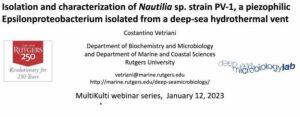On 12th of January, our speaker Costa Vetriani took us to hydrothermal vents in the deep sea of the East Pacific Rise in his talk titled “Isolation and Characterization of Nautilia sp. strain PV-1, a piezophilic Epsilonproteobacterium isolated from a deep-sea hydrothermal vent”. At these fracture zones, new oceanic crust is formed constantly and the continental plates migrate about 6-10 cm per year. Depending on the strength of the hydrothermal flow, one can distinguish between “focused flow”, which emerges directly at the vent site and is characterized by anoxic conditions and extreme temperatures of up to 400°C, and “diffusive flow” at some distance from the vent with water temperatures of max. 30°C.
In order to isolate new microorganisms from this interesting system, water samples were collected from 2500 m depth in an area with “diffusive flow” using an ROV (equipped with an isobaric sampler). This area is inhabited by tubeworms of the species Alvinella pompejana, whose microbial community is dominated by Epsilonproteobacteria. From the primary enrichment in a chemostat with CO2, H2 and nitrate at 55°C and under 25 MPa pressure (in situ conditions), a pure culture of the isolate Nautilia sp. PV-1 was obtained after some dilutions, which represents a subspecies of the species N. abyssi.
While the related species N. abyssi is piezotolerant, piezophilic behavior could be shown for strain PV-1. Even though cell numbers remained constant at different pressure conditions, the growth rate increased significantly at 20 MPa. Further physiologic characterization revealed that Nautilia sp. PV-1 is a moderately thermophilic, chemolithoautotrophic microorganism that couples the oxidation of H2 to the reduction of nitrate or elemental sulfur to generate energy. Also the genome sequencing confirmed the presence of hydrogenases and genes for nitrate utilization and sulfur metabolism. Proteogenomics indicated that under high pressure (20 MPa) mainly membrane-associated proteins were up-regulated, therefore, the fatty acid composition of the membrane at different pressures will be analyzed in more detail in the future.
We would like to thank Costa for the interesting presentation and the great scientific exchange!

